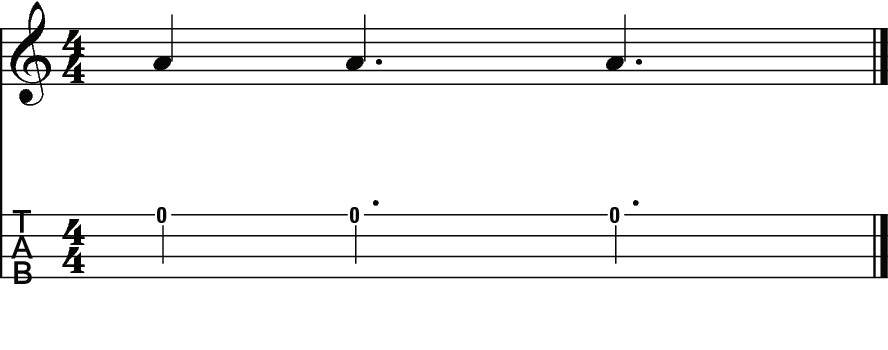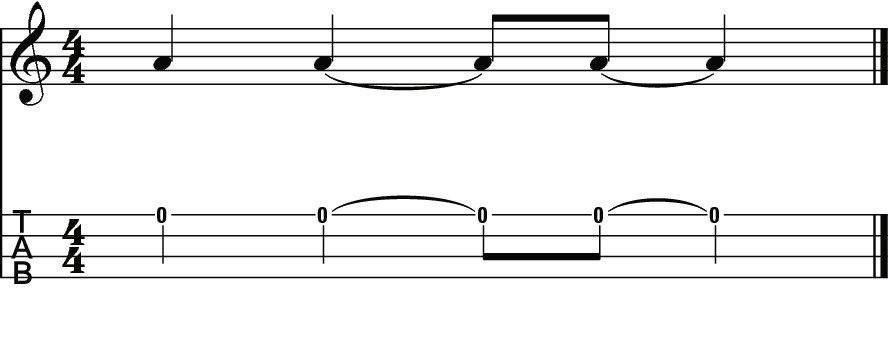Ukulele For Dummies (33 page)
Read Ukulele For Dummies Online
Authors: Alistair Wood

You can keep halving the length of notes (adding an extra flag each time) but seeing anything shorter than a sixteenth note (semiquaver) in ukulele tab is rare.
 Out in the wild, tabs vary in how much information they give about rhythm. Some tabs don't have any rhythm indicated at all and leave you to get the rhythm by listening to a recording. Some have a vague indication of rhythm given by the distance between notes and some show tab and standard notation with the latter giving the rhythm. Finally, some have rhythm lines on the tab.
Out in the wild, tabs vary in how much information they give about rhythm. Some tabs don't have any rhythm indicated at all and leave you to get the rhythm by listening to a recording. Some have a vague indication of rhythm given by the distance between notes and some show tab and standard notation with the latter giving the rhythm. Finally, some have rhythm lines on the tab.
Dotting and tying notes
Dots and ties in notation and tab perform essentially the same job â make the note that you're playing longer â but they do so in slightly different ways.
Dotted notes
Often you see dots after the note lengths. These dots increase the length of the note by half. For example, a dot after a half note (minim) increases its length by a quarter note (crotchet); that is, the note lasts for three beats.
In the example in Figure 7-15 the dots occur next to the circle of the note. Here a quarter note (crotchet) is dotted, which means that the note lasts for a quarter note (crotchet) plus an eighth note (quaver).
Figure 7-15:
An example of dotted notes: notation (top) and tab (bottom).

Tied notes
When notes are tied, you add their lengths together. The sign to indicate ties is an arch between the notes.
For instance, Figure 7-16 can be written using ties rather than dots. Here a quarter note (crotchet) is tied to an eighth note (quaver). Notice that the notes can be either way round and still be played the same way â just like saying one plus two equals three and two plus one equals three, a quarter note tied to an eighth note is the same length as an eighth note tied to a quarter.
Figure 7-16:
An example of tied notes: notation (top) and tab (bottom).

 Both Figures 7-15 and 7-16 sound the same when played (you can hear this bar on Track 23).
Both Figures 7-15 and 7-16 sound the same when played (you can hear this bar on Track 23).
Resting and Repeating
As well as indicating what notes to play and for how long (check out the preceding sections), standard notation and tab can also tell you when not to play and when to play something again.
Taking a rest
Standard notation and tab use musical signs â called rests â to show when you're not to play anything. When you see a rest make sure that you stop any notes that are sounding. You do so by taking pressure off a note you're fretting, or gently resting your finger on the string (without pressing it down) if the string is being played open.
Rests work just like standard notes (as I describe in the earlier section âReading Rhythms'). Each note has a rest equivalent to the same number of beats:
 Whole note (semibreve) rest:
Whole note (semibreve) rest:
A rectangle hanging down from the line as in bar one of Figure 7-17.
 Half note (minim) rest:
Half note (minim) rest:
A rectangle on top of a line on the stave as in bar two of Figure 7-17.
 Quarter note (crotchet) rest:
Quarter note (crotchet) rest:
A squiggle looking a bit like a bird flying sideways as in bar three of Figure 7-17.
 Eighth note (quaver) rest:
Eighth note (quaver) rest:
A diagonal line with a tail at the top (looking a bit like a percentage sign) as in bar four of Figure 7-17.
 Sixteenth note (semiquaver) rest and shorter:
Sixteenth note (semiquaver) rest and shorter:
An eighth note (quaver) rest with an extra tail as in bar five of Figure 7-17. Each time you add an extra tail you halve the length of the rest.
The rest symbols in Figure 7-17 are shown in standard notation but exactly the same symbols are used in tab.
Figure 7-17:
Rests in standard notation.

Repeating . . . and repeating
When you have to play a particular section of music more than once, standard notation and tab use repeat symbols.
A double bar line with two dots to the left â see Figure 7-18 â is the most common repeat symbol.
Figure 7-18:
Repeat from the beginning: notation (top) and tab (bottom).
